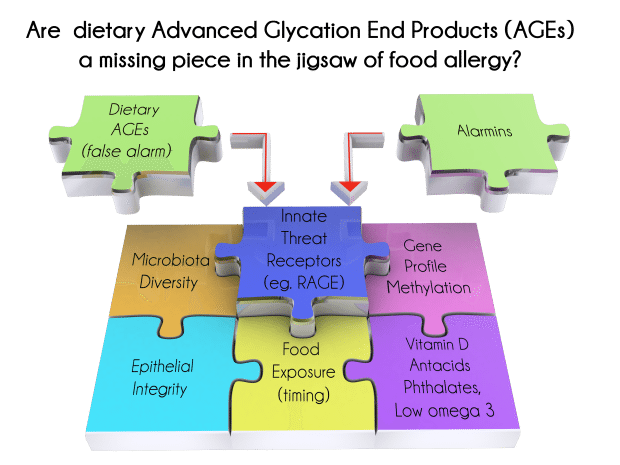Food allergy amplification all the RAGE
We recently wrote about the amplification of food anaphylaxis in Australia, where the rate of fatalities has increased 3-fold in the last 15 years. Smith and colleagues (Gold Coast, Australia and New York) have just published a paper reviewing the epidemiology, in-vitro and in-vivo studies and hypothesize a “false alarmin” method via which food allergies may develop in susceptible individuals 1. Current food allergy hypotheses (hygiene, microbiome, vitamin D, timing of introduction of solids) do not adequately or totally explain the rise of food allergies and the subsequent allergic march.
Alarmins are compounds that are released when a cell undergoes non-apoptotic cell death (injury) and a couple of key alarmins bind to the Receptor for Advance Glycation End Products (the RAGE receptor). This is a pivotal early danger signal and it enhances inflammatory and pro-allergic responses; however dietary compounds can also bind to this receptor. When foods (particularly meats) are heated to high temperature, glycolipid compounds are formed. This is enhanced with a sugar rich diet. So bacon, fried foods, soft drinks and candy appear form a substrate for ‘danger’ signals. A comprehensive dietary guide to glycation end products is available 2.
We do glycate our own proteins to create endogenous Advanced Glycation End Products (AGEs). HBA1C is glycated haemoglobin. In acute stress and injuries, hyperglycaemic response has been glycation of immunoglobulins appears to correlate with mortality with acute inflammation 3-5. Smoking increases methgyloxal (an AGE) in our bodies.
Dietary AGEs appear to be pro-inflammatory and have been implicated in arteriosclerosis, renal disease, Parkinson’s, Alzeheimer’s and ageing in general 6-9. These should be on the radar of doctors and the population at large.
The RAGE receptor that binds both dietary and endogenous alarmins, increases with inflammation, but also with obesity, stress, and with lack of exercise and sleep. From a developmental point of view, our innate immunity it trying to help us. As a society – we continue to signal danger to our bodies The health message of eating fresh food, don’t dehydrate and fry/microwave proteins, do not over-eat, make sure you have exercise, alleviate stress and get a good sleep may have foundations in the AGE-RAGE axis.
There goes burgers, fries, cola and candy!!
References
- Smith PK, Masilamani M, Li X-M, Sampson HA, “The False Alarm” hypothesis: Food allergy is associated with high dietary advanced glycation end products and pro-glycating dietary sugars that mimic alarmins, Journal of Allergy and Clinical Immunology (2016), doi: 10.1016/j.jaci.2016.05.040. [Open access PDF]
- Uribarri J et al. Advanced Glycation End Products in Foods and a Practical Guide to Their Reduction in the Diet. J Am Diet Assoc. 2010 Jun; 110(6): 911–16.e12. doi: 10.1016/j.jada.2010.03.018 [PMID PMC3704564]
- Dolhofer R, Siess EA, Wieland OH. Nonenzymatic glycation of immunoglobulins leads to an impairment of immunoreactivity. Biol Chem Hoppe Seyler. 1985 Apr;366(4):361-6. [PMID 4026990]
- Novokmet M et al. Changes in IgG and total plasma protein glycomes in acute systemic inflammation. Scientific Reports 4, Article number: 4347 doi:10.1038/srep04347
- Shankar-Hari M et al. Bench-to-bedside review: Immunoglobulin therapy for sepsis – biological plausibility from a critical care perspective Critical Care201216:206. doi: 10.1186/cc10597
- Hegab Z et al. Role of advanced glycation end products in cardiovascular disease. World J Cardiol. 2012 Apr 26; 4(4): 90–102. [PMID 3342583]
- Singh VP et al. Advanced Glycation End Products and Diabetic Complications. Korean J Physiol Pharmacol. 2014 Feb; 18(1): 1–14. [PMID 3951818]
- Srikanth V et al. Advanced glycation endproducts and their receptor RAGE in Alzheimer’s disease. Neurobiol Aging. 2011 May;32(5):763-77. [PMID 19464758]
- Gkogkolou P, Böhm M. Advanced glycation end products. Dermatoendocrinol. 2012 Jul 1; 4(3): 259–270. [PMID 3583887]

